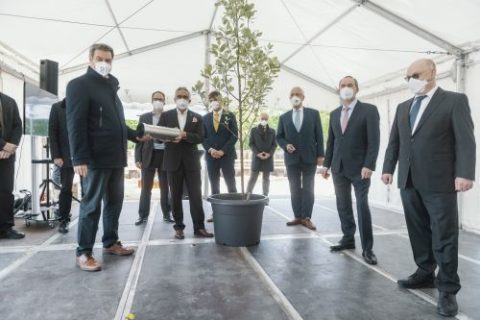An ecosystem for ideas and creativity
Foundation stone is laid for the Max Planck Centre for Physics and Medicine
‘This is a fascinating project,’ explained Bavarian Minister President Dr. Markus Söder during the foundation stone laying ceremony for the new Max Planck Centre for Physics and Medicine (MPZPM) in Erlangen. Cancer research is just one example of a field in which combining new cellular methods with processes in artificial intelligence or quantum computing is of utmost importance. The Free State of Bavaria is investing around 60 million euros in the new centre to ‘create an ecosystem for ideas and creativity’ and expedite new scientific findings. Erlangen is a particularly suitable location for the project with its strong focus on medical research and its ‘Medical Valley’. Substantial investment in the MPZPM is also an important signal for securing northern Bavaria as a further location for the Max Planck Society.
‘Today is a very important day for Bavaria and a very important day for healthcare,’ said Hubert Aiwanger, Bavarian State Minister of Economic Affairs, Regional Development and Energy. ‘The research and development activities that will take place here in the future will also make an important contribution to the Bavarian economy,’ added Aiwanger, whose area of responsibility also includes extramural research institutions in Bavaria such as the Max Planck Society.
New impetus for biomedicine
‘I am very pleased that in a few years’ time people will come together at this location who would otherwise not have been able to do so,’ added Florian Janik, mayor of the city of Erlangen. Research groups at MPZPM are currently spread out across Erlangen. In early 2024, they will move into a new building on the Universitätsklinikum Erlangen site, where the construction of the building above the ground is already in progress. The new building will house modern laboratories and offices for around 180 employees over approximately 5700 square metres Researchers will be within walking distance of medical staff at Universitätsklinikum Erlangen over glass bridges that link the buildings – an architectural feature that reflects the close connections between the founders of the MPZPM. The centre is the result of a strategic partnership between three organisations: FAU, the Max Planck Institute for the Science of Light (MPL) and Universitätsklinikum Erlangen.
Researchers from these organisations who will collaborate at the new centre specialise in modern mathematical and physical methods, particularly in the field of optics to provide new impetus to biomedical disciplines. Examples include a new type of microscope that can film the coronavirus attacking cells, a machine that measures the elasticity of blood cells and detects whether cancer cells could become a danger to the body, and simulations programmed to improve our understanding how dangerous bacteria behave.
‘Munich might shine, but Erlangen is radiant’
‘Major breakthroughs have been made in science by bringing areas of research together allowing entirely new disciplines to be created,’ said Martin Stratmann, President of the Max Planck Society, during the ceremony at the building site. However, it is not very easy these days to meet on an equal footing due to the increasing specialisation occurring in science. This applies particularly to physicists who go into increasing levels of detail in their investigations into single photons, atoms or elemental particles and medical specialists bridging disciplines to provide innovative and comprehensive patient care.
Erlangen is the ideal location for bringing these researchers together as the ‘alignment of research topics and willingness of the research institutions to collaborate is ever-present here’. With the state capital in mind, Stratmann paraphrased a famous quote from Nobel Prize winner Thomas Mann: ‘Munich might shine, but Erlangen is radiant!’
Place to be for physics and medicine
Axel Brakhage, Vice President of the German Research Foundation (DFG) agreed and added: ‘The MPZPM is a pioneering approach that could easily become a blueprint for further collaboration between institutions.’ This was also emphasised by FAU President Joachim Hornegger: ‘We want to explore the questions that determine many aspects of our lives, we want to understand how we can stay healthy and how to fight disease.’ And in five years’ time, Erlangen will be the ‘place to be’ for physics and medicine. Markus F. Neurath, Dean of the Faculty of Medicine at FAU, welcomed the location of the centre as ‘making it easier to exchange ideas and information thanks to its close proximity to patient care at Universitätsklinikum Erlangen’.
Some of the speakers also remembered the victims of the National Socialist regime who died in the neighbouring sanatorium (Heil- und Pflegeanstalt, HuPfla) during the regime’s euthanasia programme. Part of the building that formerly housed patients there was demolished to make way for the new centre, which was the subject of great debate among Erlangen’s citizens. Vahid Sandoghdar, spokesperson of the MPZPM and Director of the Max Planck Institute for the Science of Light, who originally proposed founding a centre for physics and medicine in Erlangen, thanked the people of Erlangen for setting an example in dealing with differences in opinion and reaching constructive compromises. This includes establishing the building as part of a ‘place of remembrance for future generations’ in Erlangen, a project that the MPZPM fully supports.
